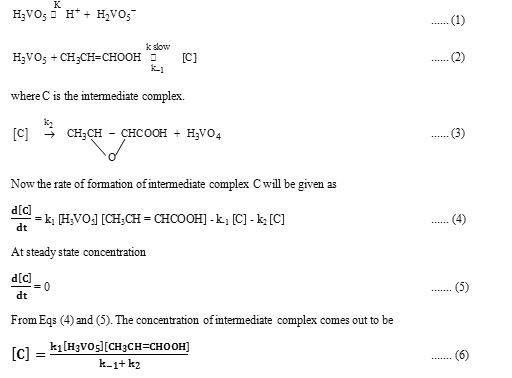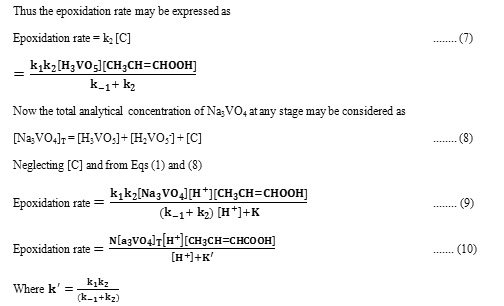Kinetics of the Epoxidation of Crotonic Acid by Aqueous Hydrogen Peroxide Catalysed by Sodium Orthovanadatae
J.V. Singh1*, Anupam Awasthi1, Dipti2, Ashish Tomar2, Davendra Singh3 and G.L. Agarwal4
1Department of Chemistry, Nehru College, Chhibramau - 209 721, Kannauj, India. 2Department of Chemistry, Meerut College, Meerut - 250 001, India. 3Faculty of Engineer and Technology, C.S.A. Univeristy of Agricultural and Technology Campus Etawah - 206 001, India. 4Department of Chemistry, Dr. H.S. Gour Vishwavidyalaya, Sagar - 470 003, India.
The kinetics of epoxidation of crotonic acid with hydrogen peroxide catalysed by sodium orthovanadate have been investigated at 400C. The rate of epoxidation reaction is first order with respect to the [substrate] and [catalyst] and zero order in hydrogen peroxide concentration. The strength of the medium shows insignificant effect on the reaction rate. Temperature dependence parameters have been computed. On the basis of kinetics and experimental results, a suitable mechanism is proposed.
KEYWORDS:Kinetics; Mechanism; Epoxidation; Sodium Orthovanadate; Hydrogen peroxide; Crotonic acid
Download this article as:| Copy the following to cite this article: Singh J. V, Awasthi A, Dipti, Tomar A, Singh D, Agarwal G. L. Kinetics of the Epoxidation of Crotonic Acid by Aqueous Hydrogen Peroxide Catalysed by Sodium Orthovanadatae. Orient J Chem 2012;28(3). |
| Copy the following to cite this URL: Singh J. V, Awasthi A, Dipti, Tomar A, Singh D, Agarwal G. L. Kinetics of the Epoxidation of Crotonic Acid by Aqueous Hydrogen Peroxide Catalysed by Sodium Orthovanadatae. Available from: http://www.orientjchem.org/?p=23179 |
Aims And Background
Since epoxides have found use as reagents, intermediate, end products, epoxidation of olefins and other organic substrates by inorganic oxidants catalysed by trasitional derivative has remained a primary goal in recent years. H2O2 becomes an efficient epoxidising agent of unsaturated compounds under the catalytic action of certain transition metal derivative. We have examined the catalytic activity of W (VI) and Mo (VI) compounds in some oxidation reaction with H2O2 as the oxidant1-3. In the present paper we report the oxidation of unsaturated organic substrate crotonic acid by V (V)-H2O2 system. The kinetic and thermodynamic parameters associated with the reaction were evaluated and the probable mechanism and rate laws were proposed.
Experimental
Materials : The substrate, crotonic acid of Ridel Dehem quality was used and its solution was prepared by dissolving the requisite amount of sample in doubly distilled water. E. Merck and B.D.H. grade sodium orthovanadate and sodium perchlorate was used for the epoxidation reaction. A fresh solution of hydrogen peroxide was used for each experiment and its strength was checked titrimetrically using acidified iodide and sodium thiosulphate4.
Kinetic Measurements: The sodium orthovanadate sodium and reaction mixture of desired concentrations containing crotonic acid and H2O2 were thermostated at 40°C (+0.1°C) in a separate flask. The pH of the solution was maintained by triethanolamine. An Elico model L1 120 digital pH meter was used for pH measurements. The reaction was started by adding the sodium orthovanadate solution (5ml) with a standard rapid delivery pipette. The instant of half delivery was noted as zero time. The total volume of the solution used was always 50ml in order to keep the reaction conditions same. The progress of the reaction was monitored by iodometric determination of unreacted hydrogen peroxide in measured aliquots (5ml) of the reaction mixture at appropriate intervals of the time as reported earlier1.
*For correspondence
By measuring the rate constants in the presence of added sodium perchlorate with all other condition constant, it was established that reaction rate were independent of the ionic strength of the medium. Subsequently the ionic strength of the reaction mixture was not controlled.
Stoichiometry and product analysis: The stoichiometry of the reaction mixture was ascertained by taking a known excess of H2O2 over crotonic acid. The presence of the epoxide in the reaction mixture was confirmed by periodate test for epoxide5. The use of free radical scavenger did not initiate polymerisation6.
Results
Kinetics of epoxidation of crotonic acid by aqueous hydrogen peroxide was investigated at several initial concentration of H2O2 crotonic acid, catalyst, NaClO4 and at different pH. Under the conditions of [substrate] > [H2O2], plots of [H2O2] versus time were linear establishing a zero order dependence in hydrogen peroxide at all concentration of the reactants Table 1 give the kinetic data of the rate of hydrogen peroxide dependence.
Table 1: Variation of rate of epoxidation with [H2O2]; [crotonic acid] = 1.0 x 10-1 mol dm-3; [Na3VO4] = 2.0 × 10-4 mol dm-3; temp. = 40°C, pH = 3.26
|
[H2O2] × 103 |
1.00 | 2.00 | 3.00 | 4.00 | 5.00 | 6.00 | 7.00 |
| 108 k0 (mol dm-3 min-1) | 0.068 | 0.073 | 0.072 | 0.071 | 0.076 | 0.078 |
0.068 |
The reaction is first order with respect to [Crotonic acid] as evident from Table 2. The observed zero order rate constant when divided by crotonic acid concentration gives a fairly constant value. A plot of lg k0 versus 1g [crotonic acid] is a straight line with a unit slope indicating first order dependences of rate on the concentration of substrate.
Table 2: Variation of rate of epoxidation with [Crotonic acid]; [H2O2] = 4.0 × 10-3 mol dm-3; [Na3VO4] = 2.0 × 10-4 mol dem-3; temp. = 40°C, pH = 3.26.
| [Crotonic acid] (mol dm-3) | 1.50 | 2.00 | 2.50 | 3.00 | 4.00 |
| 108 k0 (mol dm-3 min-1) | 0.056 | 0.070 | 0.088 | 0.097 | 0.140 |
| 106 k1 (min-1) | 0.037 | 0.035 | 0.035 | 0.032 | 0.035 |
To study the dependence of rate on catalyst, kinetic experiments have been conducted at different concentration of Na3VO4 keeping the concentration of other reactants constant. The rate of reaction was found to be first order with respect to [catalyst] (Table 3). The unit slope of the plot of 1g k0 against 1g [Na3VO4) is an indication of the first order dependence of the rate on the concentration of the sodium orthovanadate.
Table 3: Variation of rate of epoxidation with [Na3VO4]; [Crotonic acid] = 1.0 × 10-1 mol dm-3; [H2O2] = 4.0 × 10-3 mol dm-3; temp. = 40°C, pH = 3.26
| [Na3VO4] × 104 (mol dm-3) | 2.00 | 2.50 | 3.00 | 3.50 | 4.00 |
| 108 ko (mol dm-3 min-1) | 0.07 | 0.09 | 0.10 | 0.14 | 0.19 |
| 104 k1 (min-1) | 0.035 | 0.036 | 0.033 | 0.047 |
The pH dependence on the reaction was investigated at 40°C in the range 3.26-7.00 keeping the concentrations of all other reactants fixed. A perusal of Table 4 shows that the rate of reaction decrease gradually with an increase in pH in the range 3.26 to 5.50, reaches to a minimum and then slowly increases.
Table 4: Variation of rate of epoxidation on pH [Crotonic acid] = 1.0 × 10-1 mol dm-3; [H2O2] = 4.0 × 10-3 mol dm-3; [Na3O4] = 2.0 × 10-4 mol dm-3; temp. = 40°C
| pH | 3.26 | 3.50 | 4.00 | 4.50 | 5.50 | 6.50 | 7.00 |
| k0 × 108 mol dm-3 min-1 | 0.070 | 0.060 | 0.50 | 0.40 | 0.35 | 0.050 | 0.060 |
The kinetics of epoxidation of crotonic acid by H2O2 catalyzed by sodium orthovanadate has been studied at different temperatures in the range 313 K to 328 K. A plot 1g k0 of observed rate against the reciprocal of temperature was linear, and the values of activation parameters evaluated from the Arrhenius plot are presented in Table 5.
Table 5: Variation of rate of epoxidation of crotonic acid with temperature; [Crotonic acid] = 1.0 × 10-1 mol
dm-3; [H2O2] = 4.0 × 10-3; mol dm-3; pH = 3.26.
|
Temperature |
k0 × 108 mol dm-3 min-1 |
Ea KJ mol-1 |
DH* |
DG* KJ mol-1 |
-DS* JK-1 mol-1 |
|
313 |
0.070 |
– |
45.02 |
131.22 |
275.40 |
|
318 |
0.110 |
– |
44.98 |
132.60 |
275.63 |
|
323 |
0.124 |
48.00 |
44.94 |
133.98 |
275.64 |
|
238 |
0.190 |
47.25 |
44.90 |
135.36 |
275.60 |
Discussion
The preliminary experimental data suggest that H2O2 alone cannot epoxidise the substrate. The catalyst alone also fails to bring about epoxidation. This suggests the involvements of some oxygenated form of vanadium as oxygen carrier.
It has been shown7 that sodium orthovanadate changes into vanadium pentoxide in the pH range 2.2 to 6.5 Vanadium pentoxide at once reacts with hydrogen peroxide to produce a single peroxy complex as shown a study of Flood et al8 and inconclusively described as H3VO5.
![]()
The mode of dependence on the pH may be ascribed to the detaching of a proton from the peroxyvanadic acid.
The decrease of the rate with the pH corresponds to the quantitative formation of H2VO5–. The concentration of H3VO5 decrease probably due to its conversion into H2VO5– which is a slower oxidising agent than undissociated peroxyvanadic acid.
![]()
The mechanism of epoxidation of crotonic acid may be proposed by the following steps :


The above rate expression is fully consistent with the experimental observations.
It is well known that the nature of activated complex is broadly reflected in the values of S*. The entropy of activation is negative, indicating that the rate will be slower. A large negative entropies may be ascribed to a highly oriented transitions state. It has been attributed to bond formation of the substrate the oxygen from the peracids to the double bond.
Similar trend was reported by Ballisteri et al.9 that vanadium forms peroxospecies in the presence of hydrogen peroxide. This peroxspecies is electrophilic in nature which transfer oxygen to the unsaturated acids to form the epoxide.
References
- G.L. Agarwal, A. Shrivastava; Proc. Ind. Natn. Sci. Acad., 59, 169 (1993).
- G.L. Agarwal, A. Shrivastava; Revaue. Roum. de Chemie., 59, 751 (1994).
- G.L. Agarwal; J. Ind. Council. Chem. XII, 4, (1996).
- F.A. Miller, C.M. Wilkins; Anal. Chem., 24, 1853 (1952).
- D.J. Pasto, C.R. Johnson; Organic structure Determination, Prentice-Hall NJ, 376 (1969).
- P.J. Flory; Principles of polymer Chemistry Cornel. Univ. Ethaca. USA (1953).
- H. Remy; Tretise in Inorganic Chemistry, Amsterdan Elsevier II, 100 (1956).
- P. Flood, T.J. Lewis, D.H. Richard; J. Chem. Soc., 6, 5024, (1963).
- F.P. Ballistreri, A. bazoo, G.A. Tomasell, R.M. Tosceno; J. Org. Chem., 57, 7074 (1992).

This work is licensed under a Creative Commons Attribution 4.0 International License.









